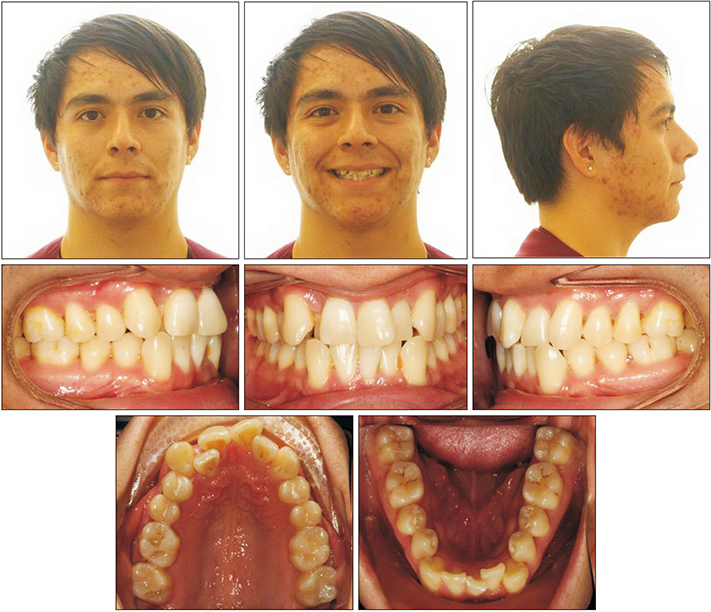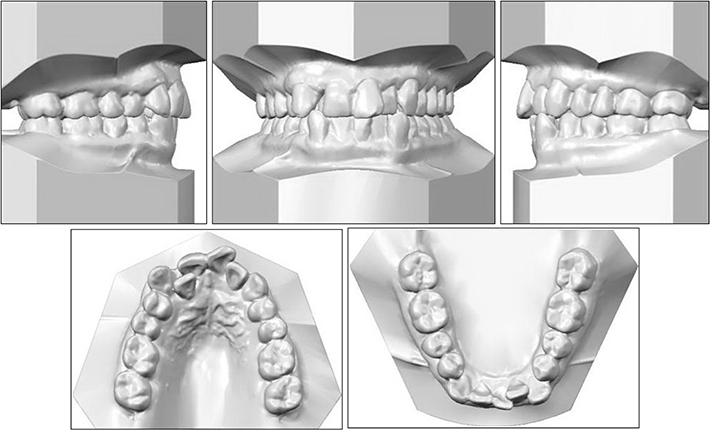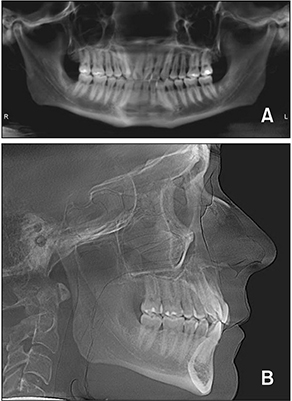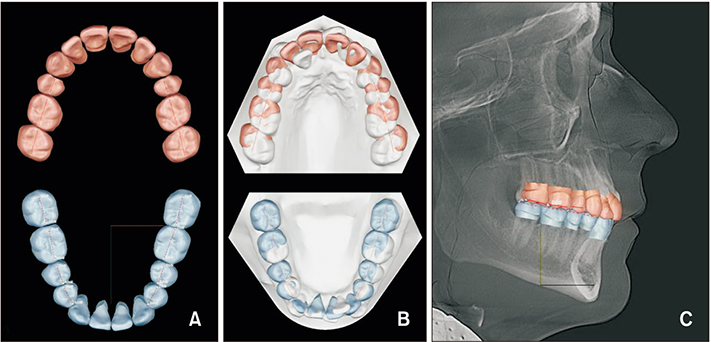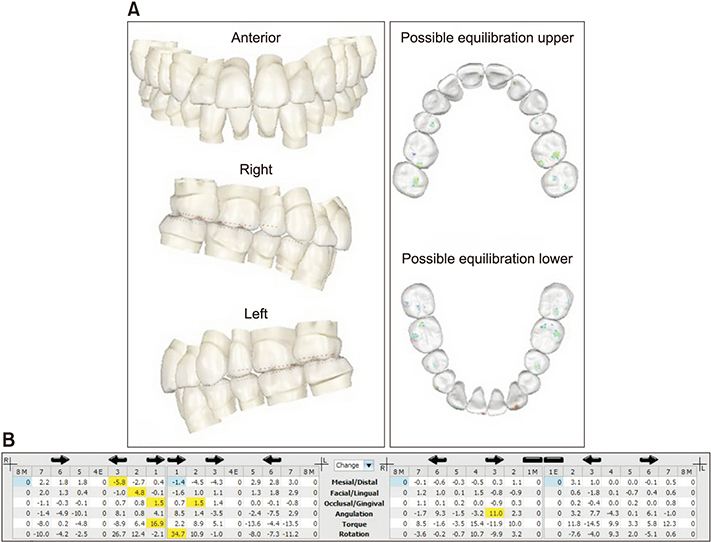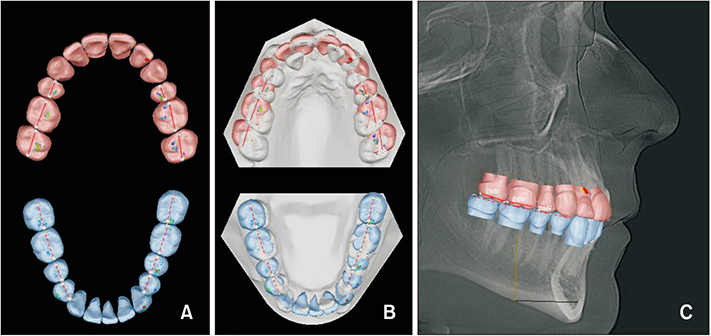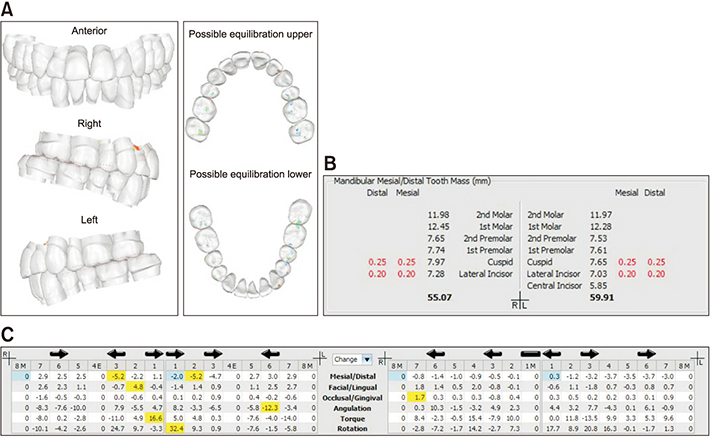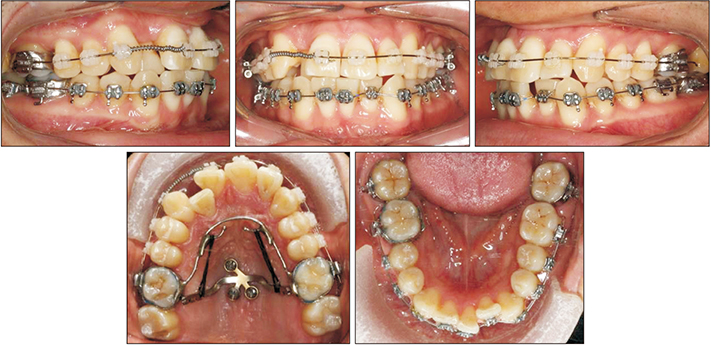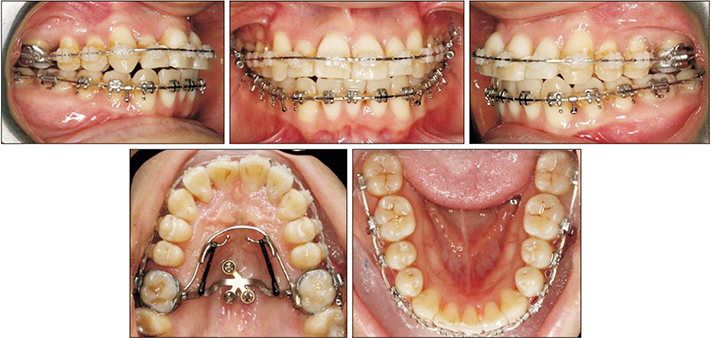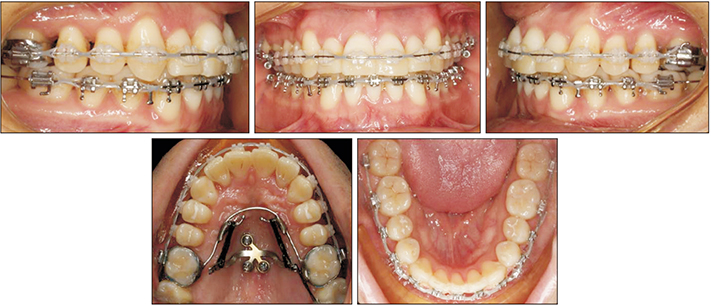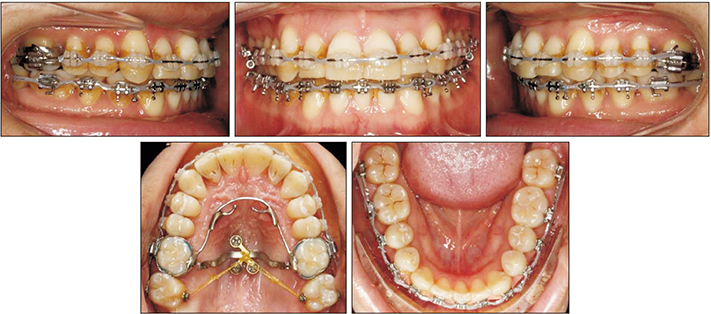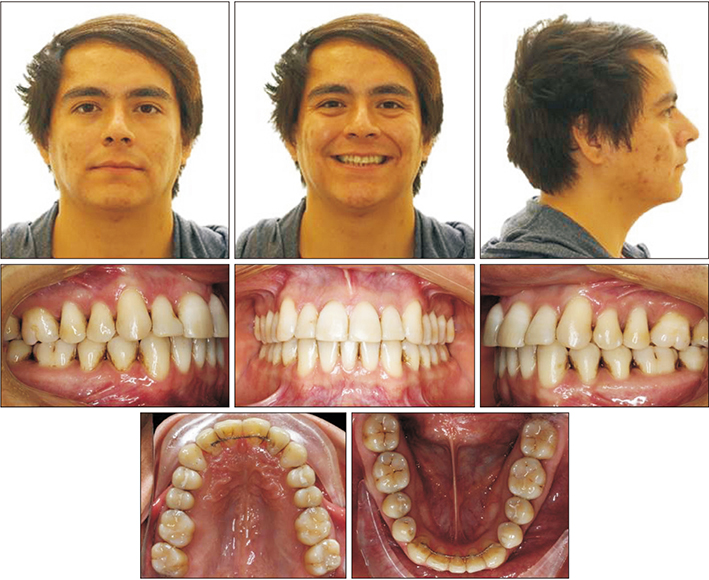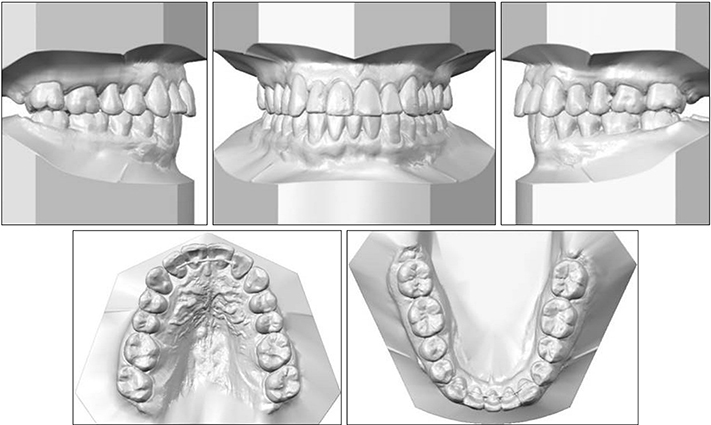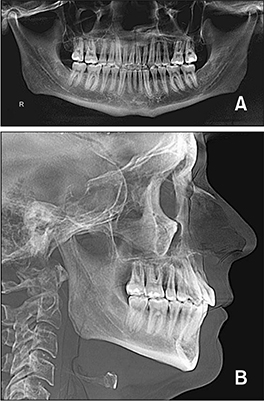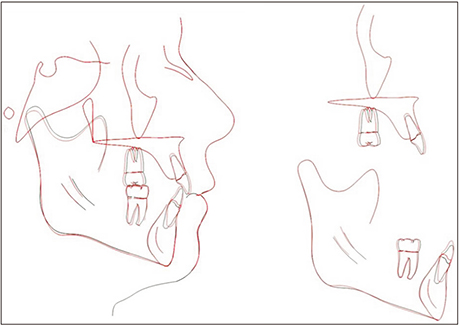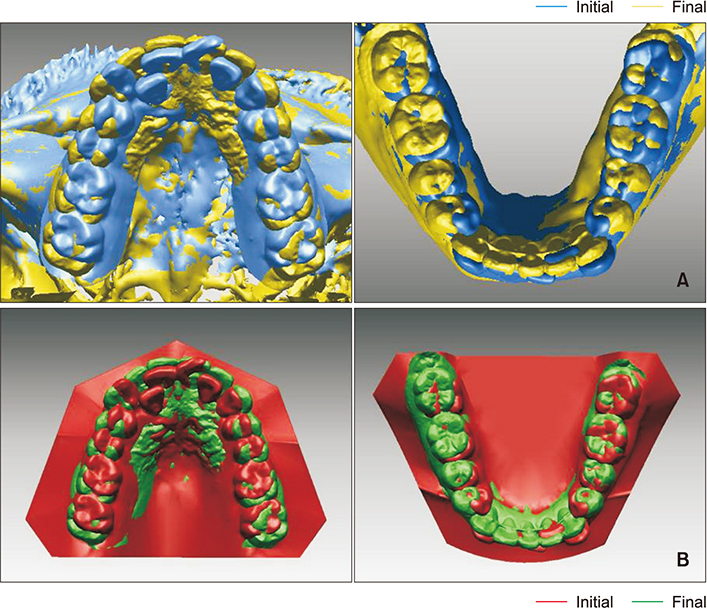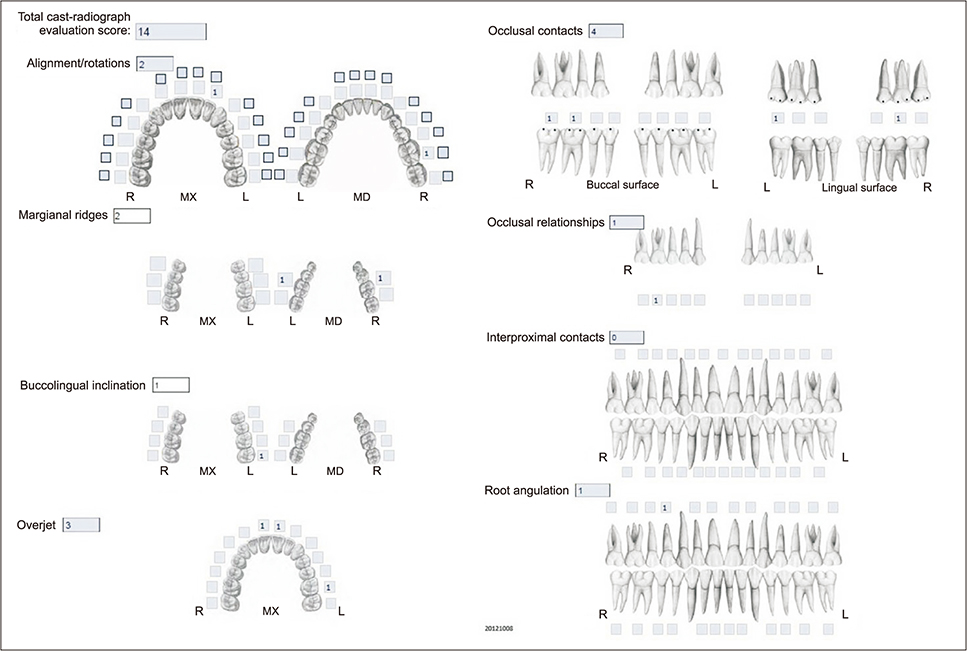Korean J Orthod.
2020 Jan;50(1):52-62. 10.4041/kjod.2020.50.1.52.
Distalization with a modified C-palatal plate for severe upper crowding and a missing lower incisor
- Affiliations
-
- 1Postgraduate Orthodontic Program, Arizona School of Dentistry & Oral Health, A.T. Still University, Mesa, AZ, USA. JPark@atsu.edu
- 2Graduate School of Dentistry, Kyung Hee University, Seoul, Korea.
- 3Private Practice, Portland, OR, USA.
- 4Department of Orthodontics, The Catholic University of Korea Seoul St. Mary's Hospital, Seoul, Korea.
- KMID: 2468641
- DOI: http://doi.org/10.4041/kjod.2020.50.1.52
Abstract
- This case report presents the orthodontic treatment of a 25-year-old patient with skeletal Class II and severe maxillary arch crowding, moderate mandibular arch crowding, anterior crossbite, and a missing lower incisor. He was treated with molar distalization using a modified C-palatal plate and temporary anchorage devices to create sufficient space for retraction. The total treatment duration was 21 months. After treatment, his occlusion and smile esthetics showed significant improvement. The modified C-palatal plate represents a treatment modality that enhances the prospects of non-extraction treatment and reduces the need for extraction.
Figure
Reference
-
1. Poulton DR. The influence of extraoral traction. Am J Orthod. 1967; 53:8–18.
Article2. Melsen B. Effects of cervical anchorage during and after treatment: an implant study. Am J Orthod. 1978; 73:526–540.
Article3. Egolf RJ, BeGole EA, Upshaw HS. Factors associated with orthodontic patient compliance with intraoral elastic and headgear wear. Am J Orthod Dentofacial Orthop. 1990; 97:336–348.
Article4. Editorial: AAO issues special bulletin on extraoral appliance care. Am J Orthod. 1975; 68:457.5. American Association of Orthodontists Bulletin. Preliminary results of headgear survey. Bull. 1982; 1:2.6. Gianelly AA, Bednar J, Dietz VS. Japanese NiTi coils used to move molars distally. Am J Orthod Dentofacial Orthop. 1991; 99:564–566.
Article7. Hilgers JJ. The pendulum appliance for Class II non-compliance therapy. J Clin Orthod. 1992; 26:706–714.8. Joseph AA, Butchart CJ. An evaluation of the pendulum distalizing appliance. Semin Orthod. 2000; 6:129–135.9. Gianelly AA, Vaitas AS, Thomas WM, Berger DG. Distalization of molars with repelling magnets. J Clin Orthod. 1988; 22:40–44.10. Gianelly AA, Vaitas AS, Thomas WM. The use of magnets to move molars distally. Am J Orthod Dentofacial Orthop. 1989; 96:161–167.
Article11. Carano A, Testa M. The distal jet for upper molar distalization. J Clin Orthod. 1996; 30:374–380.12. Bolla E, Muratore F, Carano A, Bowman SJ. Evaluation of maxillary molar distalization with the distal jet: a comparison with other contemporary methods. Angle Orthod. 2002; 72:481–494.13. Locatelli R, Bednar J, Dietz VS, Gianelly AA. Molar distalization with superelastic NiTi wire. J Clin Orthod. 1992; 26:277–279.14. Keleş A, İşgüden B. Unilateral molar distalization with molar slider (two case report). Turk J Orthod. 1999; 12:193–202.15. Chung KR, Choo H, Kim SH, Ngan P. Timely relocation of mini-implants for uninterrupted full-arch distalization. Am J Orthod Dentofacial Orthop. 2010; 138:839–849.
Article16. Kook YA, Bayome M, Trang VT, Kim HJ, Park JH, Kim KB, et al. Treatment effects of a modified palatal anchorage plate for distalization evaluated with cone-beam computed tomography. Am J Orthod Dentofacial Orthop. 2014; 146:47–54.
Article17. Kook YA, Park JH, Kim Y, Ahn CS, Bayome M. Sagittal correction of adolescent patients with modified palatal anchorage plate appliances. Am J Orthod Dentofacial Orthop. 2015; 148:674–684.
Article18. Ghosh J, Nanda RS. Evaluation of an intraoral maxillary molar distalization technique. Am J Orthod Dentofacial Orthop. 1996; 110:639–646.
Article19. Abels N, Schiel HJ, Hery-Langer G, Neugebauer J, Engel M. Bone condensing in the placement of endosteal palatal implants: a case report. Int J Oral Maxillofac Implants. 1999; 14:849–852.20. Wehrbein H, Glatzmaier J, Mundwiller U, Diedrich P. The orthosystem--a new implant system for orthodontic anchorage in the palate. J Orofac Orthop. 1996; 57:142–153.21. Yamada K, Kuroda S, Deguchi T, Takano-Yamamoto T, Yamashiro T. Distal movement of maxillary molars using miniscrew anchorage in the buccal interradicular region. Angle Orthod. 2009; 79:78–84.
Article22. Park HS, Lee SK, Kwon OW. Group distal movement of teeth using microscrew implant anchorage. Angle Orthod. 2005; 75:602–609.23. Bayome M, Park JH, Kook YA. Clinical applications and treatment outcomes with modified C-palatal plates. Semin Orthod. 2018; 24:45–51.
Article24. Florvaag B, Kneuertz P, Lazar F, Koebke J, Zöller JE, Braumann B, et al. Biomechanical properties of orthodontic miniscrews. An in-vitro study. J Orofac Orthop. 2010; 71:53–67.
Article25. Ryu JH, Park JH, Vu Thi, Bayome M, Kim Y, Kook YA. Palatal bone thickness compared with cone-beam computed tomography in adolescents and adults for mini-implant placement. Am J Orthod Dentofacial Orthop. 2012; 142:207–212.
Article26. Mah SJ, Kim JE, Ahn EJ, Nam JH, Kim JY, Kang YG. Analysis of midpalatal miniscrew-assisted maxillary molar distalization patterns with simultaneous use of fixed appliances: a preliminary study. Korean J Orthod. 2016; 46:55–61.
Article27. Yu IJ, Kook YA, Sung SJ, Lee KJ, Chun YS, Mo SS. Comparison of tooth displacement between buccal mini-implants and palatal plate anchorage for molar distalization: a finite element study. Eur J Orthod. 2014; 36:394–402.
Article28. Vu T, Bayome M, Kook YA, Han SH. Evaluation of the palatal soft tissue thickness by cone-beam computed tomography. Korean J Orthod. 2012; 42:291–296.
Article29. Kook YA, Park JH, Bayome M, Jung CY, Kim Y, Kim SH. Application of palatal plate for nonextraction treatment in an adolescent boy with severe overjet. Am J Orthod Dentofacial Orthop. 2017; 152:859–869.
Article
- Full Text Links
- Actions
-
Cited
- CITED
-
- Close
- Share
- Similar articles
-
- Total arch distalization with interproximal stripping in a patient with severe crowding
- Malocclusion with congenital missing of lower incisors
- Comparison of treatment effects between four premolar extraction and total arch distalization using the modified C-palatal plate
- A study of dental crowding and its relationship to mandibular incisor shape by model analysis in adolescents
- The case report of the skeletal Angle's Class II malocclusion with the upper central incisor missing

